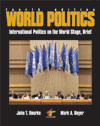The 1992 UN Conference on Environment and Development
(UNCED) meeting in Rio de Janeiro symbolizes the concern with the
environment and the political issues surrounding sustainable development.
Popularly dubbed the Earth Summit, the conference, with Canadian diplomat
Maurice Strong serving as secretary-general, was attended by 178 countries
and 115 heads of state. Some 8,000 journalists covered the proceedings,
and 15,000 representatives of NGOs and national citizens' groups flocked
to Brazil (Willets, 1996). By its end, the conference produced Agenda
21
(an 800-page document covering 112 topics that constitute a nonbinding
blueprint for sustainable development in the twenty-first century)
and two treaties (the Biodiversity and the Global Warming Conventions). Additionally, the conduct of the Earth Summit illustrates
the politics of environmental protection. Preliminary negotiations
made it clear that environmental issues can be very political (Porter
& Brown, 1996). In particular, the North and the South were at odds
on many issues. The EDCs objected to and were able to defeat efforts
by the LDCs to force the EDCs to set binding timetables to cut down
on the use of fossil fuels and to reduce emissions of carbon dioxide
and other gases that contribute to global warming. For its part, the South resisted and was able to defeat
restrictions on the use of forest resources proposed by the North
(Miller, 1995b). "Forests are clearly a sovereign resource--not
like atmosphere and oceans, which are a global commons," said
We Lian Ting, Malaysia's chief negotiator. "We cannot allow forests
to be taken up in global forums."1 Instead, the LDCs proposed
a statement guaranteeing their "sovereign and inalienable right
to use, manage, and develop their forests in accordance with their
development needs." Funding was another issue that split North and South.
Many environmental programs are expensive, and Secretary-General Strong
estimated that the LDCs would annually need $125 billion for new environmental
programs. He proposed an initial EDC commitment of $5 to $10 billion
a year for these programs, but the South wanted an even stronger financial
commitment. The LDCs wanted to stipulate that the North had caused
a disproportionate share of environmental damage and, therefore, should
be primarily responsible for financing preservation and reclamation
programs. To accomplish this, the LDCs wanted a statement saying that
the EDCs would commit to raising their foreign aid to 0.7 percent
of each EDC's GDP. This would have increased aid for 1992 by about
$60 billion. The North rejected these ideas. "We do not have an
open pocketbook," President George Bush observed.2 In the
end, EDCs committed to the theory of added funding, but, after a two-year
delay, agreed to provide just $2 billion in extra aid over three years
to LDCs for environmental improvement. The funds are channeled through
the Global Environmental Facility (GEF), which is jointly administered
by the UN and the World Bank. As of mid-1996, the GEF had extended
about $1.2 billion in aid to 186 environmental projects in 90 countries. In the end, 153 countries signed both the Biodiversity
and the Global Warming Conventions, and other countries signed one
or the other. Even though neither treaty created legally binding mandates,
President Bush attached a reservation to his signature of the Global
Warming Convention, saying that the United States would not be bound
by the timetables for reducing greenhouse gas emissions. He also refused
to sign the Biodiversity Convention on the grounds that it did not
protect intellectual property rights in biotechnology. Among other
critics, India's environment minister, Kamal Nath, quipped that the
only biodiversity that interested the U.S. administration was the
political survival "of bushes and quails."3 Less than
a year later, a new U.S. president, Bill Clinton, marked the annual
Earth Day, April 21, by signing the biodiversity pact and rescinding
the U.S. reservation to the timetables in the Global Warming Convention. Was the Earth Summit a success? Norway's prime minister,
Gro Harlem Brundtland, observed, "We owe the world to be frank
about what we have achieved in Rio." That is, she said, "progress
in many fields, too little progress in most fields, and no progress
at all in some fields."4 The important point is that the
Earth Summit was a step forward. Not long ago, no one paid any attention
to the environment, much less did anything about it. In June 1992,
representatives of almost every country on Earth gathered to affirm
their support of sustainable development. Principles were established
on many issues and a few commitments were made. Even though it was
limited, progress was made. Moreover, the 1992 meeting set in progress
a process that may lead to other successes. The GEF is receiving and
distributing funds. These are limited, but they are greater than the
zero that existed before 1992. The signatories of the Global Warming
Convention met in Berlin in 1995 and again in Japan in 1997. This
latter meeting and its impact are discussed later in the chapter in
the box "To Kyoto and Beyond." Notes 1. New York Times, June 12, 1992, p. A9. 2. Hartford Courant, June 8, 1992, p. A2. 3. Hartford Courant, June 15, 1992, p. A1. 4. Hartford Courant, June 15, 1992, p. A1 |



 2002 McGraw-Hill Higher Education
2002 McGraw-Hill Higher Education